A decision diagram based backend for tensor calculation, which is especially suitable for quantum circuit simulation.
Project description
TddPy
A decision diagram based backend for tensor calculation, which is especially suitable for quantum circuit simulation.
An introduction to TDD (Tensor Network Decision Diagram) can be found at:
Installation
- Platform: Windows, Linux
- Python Version: Python 3.9
pip3 install tddpy
The graphing methods in TddPy rely on the graphviz package, which cannot be installed automatically. Please download here and install it manually.
TddPy supports CUDA devices for calculation. To enable this ability, follow the instructions after installing TddPy:
- The NVIDIA CUDA Toolkit is needed, whose installation package can be downloaded here.
- Uninstall the original CPU version PyTorch with
pip3 uninstall torch
- Install the corresponding CUDA version of PyTorch
pip3 install torch --extra-index-url https://download.pytorch.org/whl/cu113
Note that after installation, sometimes the manual setting of library path is needed. To be specific, the library path can be:
.../anaconda3/lib
.../anaconda3/lib/python3.9/site-packages/torch/lib
Documentation
To be written ...
Tutorials
TDD Construction
Here, we convert the CZ (controlled-Z) gate to a TDD, in the trival storage order, and output the graph picture.
import numpy as np
import tddpy
cz = np.array([[1., 0., 0., 0.],
[0., 1., 0., 0.],
[0., 0., 1., 0.],
[0., 0., 0., -1.]]).reshape((2,2,2,2))
cz_tdd = tddpy.TDD.as_tensor(cz)
print(cz_tdd.numpy())
cz_tdd.show("cz_tdd")
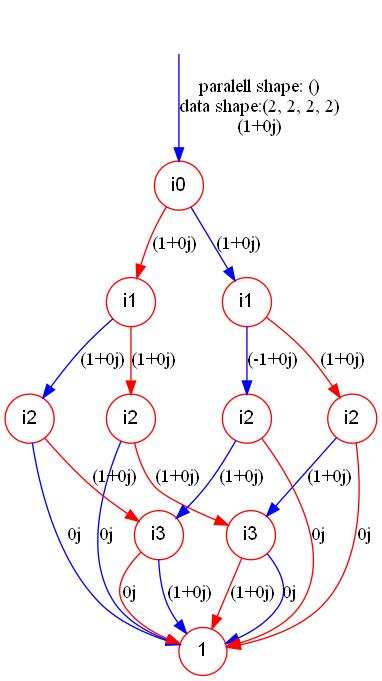
Specifying Storage Order
We then try to store the CZ gate in the paired storage order to get a more compact TDD. Note that a tuple of (tensor, parallel index number, storage order) is passed in as the parameter. The storage order will only influence the inner storage in TDD, not the tensor represented.
import numpy as np
import tddpy
cz = np.array([[1., 0., 0., 0.],
[0., 1., 0., 0.],
[0., 0., 1., 0.],
[0., 0., 0., -1.]]).reshape((2,2,2,2))
cz_tdd = tddpy.TDD.as_tensor((cz, 0, [0,2,1,3]))
print(cz_tdd.numpy())
cz_tdd.show("cz_tdd_compact")
And the result TDD is:
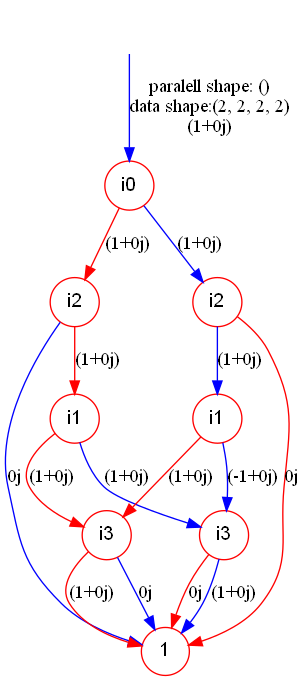
Tracing
The interface for tracing and contraction (tensordot) is almost the same with that of Numpy or PyTorch. For example, we trace the second and third index of CZ:
import numpy as np
import tddpy
cz = np.array([[1., 0., 0., 0.],
[0., 1., 0., 0.],
[0., 0., 1., 0.],
[0., 0., 0., -1.]]).reshape((2,2,2,2))
cz_tdd = tddpy.TDD.as_tensor((cz, 0, [0,2,1,3]))
res_trace = cz_tdd.trace([[1],[2]])
print(res_trace.numpy())
res_trace.show("cz_tdd_traced")

Contraction
The successive application of two CZ gates results in the identity gate. This can be observed by contraction of CZ tensors in the TDD form:
import numpy as np
import tddpy
cz = np.array([[1., 0., 0., 0.],
[0., 1., 0., 0.],
[0., 0., 1., 0.],
[0., 0., 0., -1.]]).reshape((2,2,2,2))
cz_tdd = tddpy.TDD.as_tensor((cz, 0, [0,2,1,3]))
res_cont = tddpy.TDD.tensordot(cz_tdd, cz_tdd, [[2,3],[0,1]])
print(res_cont.numpy())
res_cont.show("cz_tdd_cont")
And the reuslt TDD is:
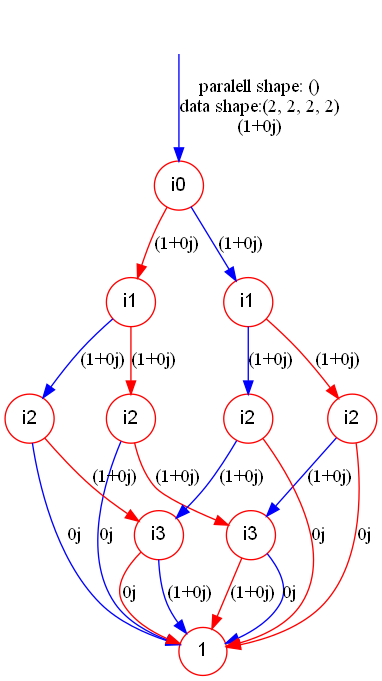
Rearrangement of Contraction
A rearrangement of remained indics from TDD A and B, after their contraction, can be specified to get the better inner storage. In the last example, we can specify the rearrangment to get the paired storage order:
import numpy as np
import tddpy
cz = np.array([[1., 0., 0., 0.],
[0., 1., 0., 0.],
[0., 0., 1., 0.],
[0., 0., 0., -1.]]).reshape((2,2,2,2))
cz_tdd = tddpy.TDD.as_tensor((cz, 0, [0,2,1,3]))
rearrangement = [True, False, True, False]
res_cont = tddpy.TDD.tensordot(cz_tdd, cz_tdd, [[2,3],[0,1]], rearrangement)
print(res_cont.numpy())
res_cont.show("cz_tdd_cont_rearranged")
And the result will become much more compact:
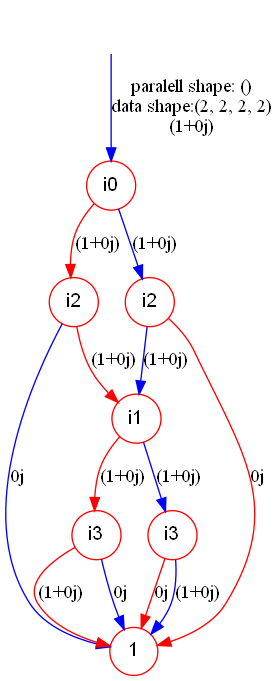
Tensor Weight TDD
For TDDs of the same graph structure, we can "stack" them together to get the tensor weight TDD. For example, the TDD in next example represents the tensor $$ [R_x(\theta_1)\ R_x(\theta_2)\ R_x(\theta_3)]. $$
import torch
import tddpy
from tddpy.CUDAcpl import quantum_circ
theta = torch.rand((3,), dtype = torch.double)
layer1 = quantum_circ.Rx(theta)
layer1_tdd = tddpy.TDD.as_tensor((layer1, 1, []))
print(layer1_tdd.numpy())
layer1_tdd.show("tensor_weight")
And the tensor weight TDD looks like
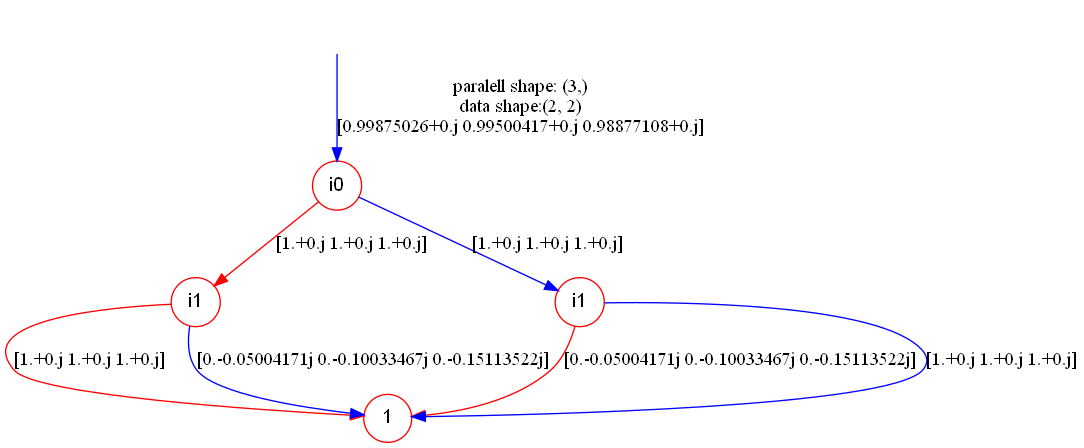
Hybrid Contraction
Contraction can be conducted among scalar weight or tensor weight TDDs. For example, we can apply the Hadamard gate (scalar weight TDD) after multiple $R_x(\theta_i)$ gates (tensor weight TDD).
import torch
import tddpy
from tddpy.CUDAcpl import quantum_circ
h_tdd = tddpy.TDD.as_tensor(quantum_circ.hadamard())
theta = torch.tensor([0.1, 0.2, 0.3], dtype = torch.double)
layer1 = quantum_circ.Rx(theta)
layer1_tdd = tddpy.TDD.as_tensor((layer1, 1, []))
res_cont = tddpy.TDD.tensordot(h_tdd, layer1_tdd, [[1],[0]])
print(res_cont.numpy())
res_cont.show("hybrid_cont_res")
And the result looks like
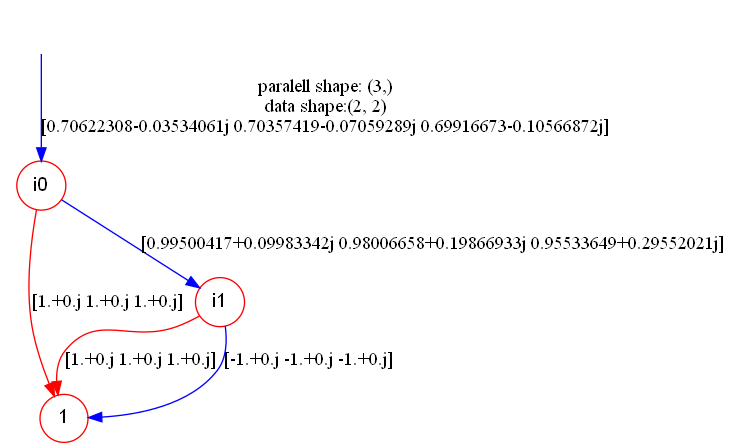
Order Coordinator
The Order coordinator is an extra design above TDD, which provides the interface to designate the strategy for storage order and rearrangement. It is intended for auto contraction in tensor network frameworks.
Settings
The run-time settings for tddpy package can be adjusted by the method
tddpy.reset(thread_num, device_cuda, dtype_double, eps, gc_check_period, vmem_limit_MB)
It designates the thread number in parallelism, the device for tensor weight calculation, the float number type, the float comparison EPS and garbage collection settings.
Contact
If you have any question, don't hesitate to contact lucianoxu@foxmail.com
Project details
Release history Release notifications | RSS feed
Download files
Download the file for your platform. If you're not sure which to choose, learn more about installing packages.
Source Distributions
Built Distribution
File details
Details for the file TddPy-1.0b31-py3-none-any.whl.
File metadata
- Download URL: TddPy-1.0b31-py3-none-any.whl
- Upload date:
- Size: 1.4 MB
- Tags: Python 3
- Uploaded using Trusted Publishing? No
- Uploaded via: twine/3.8.0 pkginfo/1.8.2 readme-renderer/34.0 requests/2.26.0 requests-toolbelt/0.9.1 urllib3/1.26.7 tqdm/4.62.3 importlib-metadata/4.8.1 keyring/23.1.0 rfc3986/2.0.0 colorama/0.4.4 CPython/3.9.7
File hashes
| Algorithm | Hash digest | |
|---|---|---|
| SHA256 | be1d69fdfa4eecdd24973a16e8681a2139191511ddf57a1f00070848b095c01e |
|
| MD5 | 143a98b73dfcd70d97c3e3c348b4665e |
|
| BLAKE2b-256 | 9dd3f1b369cfcfcfb49d7bfdeb996ee8a61442c21059e3cdebc3903dbfd2849d |












